
Acanthaceae is a family of dicotyledonous flowering plants containing almost 250 genera and about 2500 species. Most are tropical herbs, shrubs, or twining vines; some are epiphytes. Only a few species are distributed in temperate regions. The four main centres of distribution are Indonesia and Malaysia, Africa, Brazil, and Central America. Representatives of the family can be found in nearly every habitat, including dense or open forests, scrublands, wet fields and valleys, sea coast and marine areas, swamps, and mangrove forests.

Abrus is a genus of flowering plants in the pea family, Fabaceae, and the only genus in the tribe Abreae. It contains 13–18 species, but is best known for a single species: jequirity. The highly toxic seeds of that species are used to make jewellery.
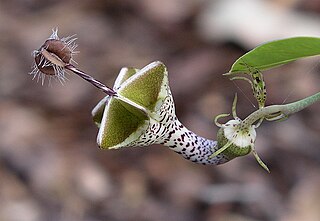
Ceropegia is a genus of plants within the family Apocynaceae, native to Africa, southern Asia, and Australia. It was named by Carl Linnaeus, who first described this genus in his Genera plantarum, which appeared in 1737. Linnaeus referred to the description and picture of a plant in the Horti Malabarici as the plant for which the genus was created. In 1753 he named this species as Ceropegia candelabrum. Linnaeus did not explain the etymology but later explanations stated that the name Ceropegia was from the Greek word keropegion κηροπηγɩον. This means candelabrum in Latin, which has a broader range than the modern word - "a candlestick, a branched candlestick, a chandelier, candelabrum, or also lamp-stand, light-stand, sometimes of exquisite workmanship".

Adenium is a genus of flowering plants in the family Apocynaceae first described as a genus in 1819. It is native to Africa and the Arabian Peninsula.
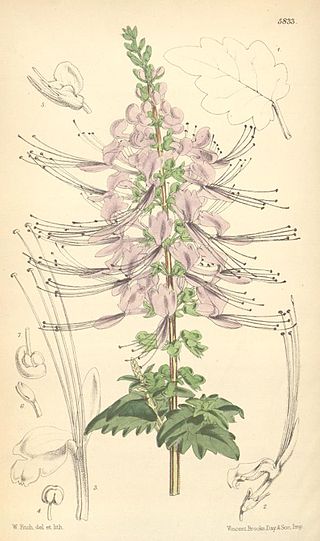
Orthosiphon is a genus of plants in the family Lamiaceae native to Africa, Southern Asia and Queensland, with one species (O. americanus) in Colombia. They are herbaceous shrubs which grow to a height of 1.5 m (5 ft). Some Orthosiphon species are popular garden plants because of their flowers, which are white and bluish with filaments resembling a cat's whiskers. In the wild, the plants can be seen growing in forests and along roadsides.

Dombeya is a flowering plant genus. Traditionally included in the family Sterculiaceae, it is included in the expanded Malvaceae in the APG and most subsequent systematics. These plants are known by a number of vernacular names which sometimes, misleadingly, allude to the superficial similarity of flowering Dombeya to pears or hydrangeas. Therefore, the genus as a whole is often simply called dombeyas. The generic name commemorates Joseph Dombey (1742–1794), a French botanist and explorer in South America, involved in the notorious "Dombey affair", embroiling scientists and governments of France, Spain, and Britain for more than two years.

Melhania is a genus of small shrubs or herbaceous plants. Traditionally included in the family Sterculiaceae, it is included in the expanded Malvaceae in the APG and most subsequent systematics. The genus is named for Mount Melhan in Yemen.

Dactyloctenium is a genus of Asian, African, and Australian plants in the grass family. There are about 13 species in the genus in the world, in which 3 are known to occur in India. A common name for the plants is crowfoot grasses.

Anisotes is a genus of Afrotropical plants in the family Acanthaceae. The genus is morphologically similar to Metarungia, from which it differs mainly in the dehiscence of the fruit capsule, and the nature of the placenta. Placentas remain attached to the inner surface of fruit capsules in Anisotes.

Faurea is a genus containing 16 species of flowering plants in the protea family which occur in the summer rainfall area of southern Africa, extending to tropical Africa and Madagascar. The name honours South African soldier and botanist William Caldwell Faure (1822-1844) who was killed on active service in India.

Neuracanthus is a genus of flowering plants in the family Acanthaceae. It includes 32 species native to tropical Africa, Madagascar, the Arabian Peninsula, Indian subcontinent, and Indochina.
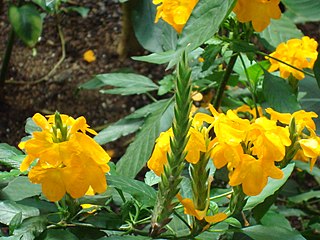
Crossandra is a genus of plants in the family Acanthaceae, comprising 54 species that occur in Africa, Madagascar, Arabia and the Indian subcontinent. Some species, especially Crossandra infundibuliformis, are cultivated for their brightly colored flowers.
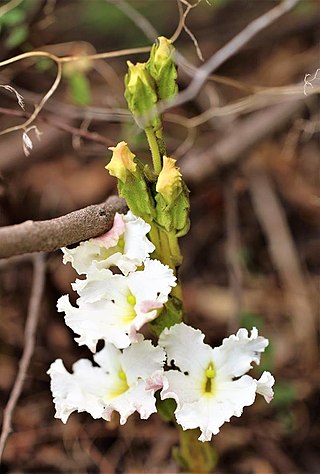
Harveya is a genus of parasitic plants in the family Orobanchaceae. The approximately 29 species included are native to Africa from Eritrea to South Africa, Madagascar and the Mascarene Islands, the Arabian Peninsula, and Turkmenistan in Central Asia. In South Africa they are commonly known as 'inkblom', because early settlers used the flowers to make ink, and this is the source of the English common-names for the genus of ink flower or ink plant.

Cadia is a genus of flowering plants in the family Fabaceae which belongs to the subfamily Faboideae. It includes 8 species native to northeastern Africa, the Arabian Peninsula, and Madagascar.

Hermannia is a genus of flowering plants in the mallow family, Malvaceae. It comprises at least 65 species with many more species as yet unresolved.
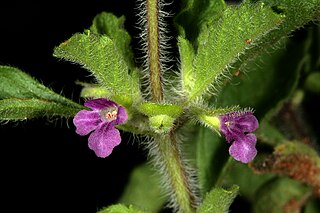
Endostemon (keepsafe) is a genus of plants in the family Lamiaceae, first described in 1910. It is native primarily to eastern Africa, with some species in central and southern Africa, the Arabian Peninsula, Madagascar, and the Indian subcontinent.
- Endostemon albusA.J.Paton, Harley & M.M.Harley - Kenya, Tanzania, Mozambique
- Endostemon camporum(Gürke) M.R.Ashby - Kenya, Tanzania
- Endostemon ctenoneurusHarley - Kenya, Somalia
- Endostemon glandulosusHarley & Sebsebe - Ethiopia
- Endostemon gracilis(Benth.) M.R.Ashby - Kenya, Somalia, Tanzania, Yemen
- Endostemon kelleri(Briq.) Ryding ex A.J.Paton & Harley - Kenya, Somalia, Ethiopia
- Endostemon leucosphaerus(Briq.) A.J.Paton, Harley & M.M.Harley - Somalia, Ethiopia
- Endostemon membranaceus(Benth.) Ayob. ex A.J.Paton & Harley - Cameroon, Angola, Central African Republic
- Endostemon obbiadensis(Chiov.) M.R.Ashby - Somalia
- Endostemon obtusifolius(E.Mey.) N.E.Br. - from South Africa north to Angola and Tanzania
- Endostemon racemosusRyding, A.J.Paton & Thulin - Somalia
- Endostemon stenocaulis(Hedge) Ryding, A.J.Paton & Thulin - Somalia
- Endostemon tenuiflorus(Benth.) M.R.Ashby - eastern + southern Africa, Madagascar, Arabian Peninsula
- Endostemon tereticaulis(Poir.) M.R.Ashby - widespread across much of tropical Africa, also Yemen + Saudi Arabia
- Endostemon tomentosusHarley & Sebsebe - Somalia
- Endostemon tubulascens(Briq.) M.R.Ashby - Angola
- Endostemon usambarensisM.R.Ashby - Tanzania
- Endostemon villosus(Briq.) M.R.Ashby - central Africa
- Endostemon viscosus(Roth) M.R.Ashby - India, Assam, Sri Lanka
- Endostemon wakefieldii(Baker) M.R.Ashby - Kenya

Ecbolium is a genus of flowering plants in the family Acanthaceae. It includes 26 species native to southern and eastern Africa, the Arabian Peninsula, Indian subcontinent, and Myanmar.

Aloeae is a tribe of succulent plants in the subfamily Asphodeloideae of the family Asphodelaceae, consisting of the aloes and their close relatives. The taxon may also be treated as the subfamily Alooideae by those botanists who retain the narrower circumscription of Asphodelaceae adopted prior to the APG III system. Typically, plants have rosettes of more or less succulent leaves, with or without a distinct stem. Their flowers are arranged in racemes and tend to be either small and pale, pollinated by insects, or larger and more brightly coloured, pollinated by birds. As of 2017, 11 genera are recognized, most created since 2010 by splitting off another five genera from Aloe and another two from Haworthia. Only two genera, Aloe and Aloidendron, are native outside southern Africa, extending northwards to the Arabian Peninsula. Seven genera are restricted to South Africa, some with small ranges. Members of the Aloeae are cultivated by succulent plant enthusiasts; Aloe species especially are used in temperate climates as ornamental garden plants. Some species are used in traditional medicine. Aloe vera and Aloe ferox are cultivated for their extracts, whose uses include moisturizers and emollients in cosmetics.
Digera muricata is a species of flowering plant belonging to the family Amaranthaceae. It is the sole species in genus Digera. It is an annual native to parts of Africa and Asia, ranging from Egypt to Tanzania in eastern Africa, and to Madagascar, the Arabian Peninsula, Afghanistan, the Indian Subcontinent, Myanmar, southeastern China, Sumatra, Java, Sulawesi, and the Maluku Islands.

Plicosepalus is a genus of hemiparasitic flowering plants belonging to the family Loranthaceae.



















